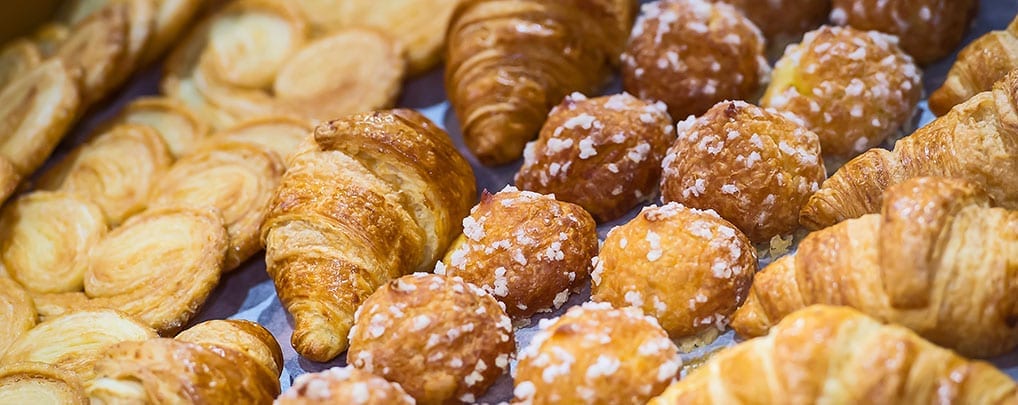Premier Bakery Catering Maddington for Appetizing Treats
Premier Bakery Catering Maddington for Appetizing Treats
Blog Article
Comprehending the Art of Bakeshop Products: From Fresh Baked Breads to Irresistible Pastries and Finger Foods
From the science behind the perfect loaf of bread, where fermentation and gluten development play critical functions, to the skill required for creating split breads, each element exposes a compelling narrative of workmanship. The convenience of finger foods highlights just how flavor and appearance can be skillfully integrated to engage diverse preference choices.
The Science of Bread Making
At the heart of every loaf of bread exists an interesting interplay of chemistry and biology. The procedure of bread making begins with the mix of flour, yeast, salt, and water-- each ingredient playing a crucial duty in the end product. Flour consists of proteins, mostly glutenin and gliadin, which, when combined with water, form gluten (Catering Maddington). This elastic network is essential for capturing gases generated during fermentation.
Yeast, a living organism, ferments the sugars existing in the flour, creating co2 and alcohol in the process. The co2 gas develops bubbles in the dough, causing it to climb and develop a light structure. The temperature level and moisture during fermentation substantially affect yeast task and, consequently, the bread's taste and appearance.

Mastering Bread Methods
How can one attain the delicate equilibrium of structure and taste that defines exceptional bread? Mastering pastry strategies needs a deep understanding of ingredients, techniques, and the scientific research behind them. Essential to this craft is the option of premium ingredients-- flour, butter, sugar, and eggs-- each playing a vital role in the last item's flavor and appearance.
The technique of lamination, which includes folding layers of dough and butter, develops the desired flakiness in breads like croissants and smoke pastry. Precision in temperature level is vital, as butter must remain chilly to make certain optimal layers. Likewise, appropriate blending approaches, such as the creaming technique for cakes, make sure also incorporation of air and fat, leading to a light and ventilated crumb.
Additionally, keeping the right humidity levels throughout cooking can dramatically affect the outcome, guaranteeing that breads increase appropriately and attain that golden-brown finish. Finally, the art of pastry likewise demands persistence and technique; each effort boosts one's ability and understanding of the detailed equilibrium called for to produce tempting breads that thrill the detects. Mastery in these methods eventually differentiates a knowledgeable bread cook from an amateur.
Sorts Of Finger Foods
The world of culinary thrills expands past pastries to encompass a wide array of finger foods, which are celebrated for their ease and convenience. These bite-sized deals with are best for social events, offering an array of tastes and structures that deal with diverse tastes.

On the sweeter side, bite-sized cupcakes and miniature tarts offer a delightful surface to any type of dish, appealing to those with a craving for sweets. Additionally, cheese and charcuterie boards act as an innovative choice, allowing guests to personalize their bites with a variety of meats, nuts, cheeses, and fruits.
Taste Profiles in Baking
Baking is an elaborate dance of flavor profiles that combines wonderful, savory, and umami notes to create a harmonious experience for the palate. Understanding these profiles is essential for bakers looking for to raise their developments.
Ingredients such as delicious chocolate and caramel present complex pleasant notes that can either control or match various other flavors. Active ingredients like herbs, cheeses, and seasonings can change a simple dough into a complex flavor experience.
Umami, often overlooked in baking, plays a significant function in enriching tastes. Ingredients such as aged cheeses, fermented products, or also certain nuts add to a savory depth that boosts overall taste.
In addition, the interplay of acidity from ingredients like buttermilk or citrus passion can lighten up flavors, providing a revitalizing counterpoint to sweetness. By thoughtfully integrating these taste accounts, bakers can craft products that resonate with diverse tastes, producing an unforgettable culinary experience. Eventually, understanding taste accounts is key to advancement on the check these guys out planet of cooking.
Important Baking Equipments and Active Ingredients
Understanding flavor profiles in baking collections the phase for picking the right devices and active ingredients that facilitate the creation of extraordinary baked products. The structure of effective baking lies in having important tools at hand. why not try these out Secret products include mixing bowls, measuring cups, and spoons for precision, as well as a durable stand mixer or hand mixer for uncomplicated mixing. A trustworthy collection of cooking pans-- such as sheet pans, loaf pans, and cake frying pans-- is crucial for achieving wanted structures and forms.
Flour offers as the backbone of a lot of recipes; selecting the right type-- be it pastry, bread, or all-purpose flour-- can substantially affect the end result. Baking powder and cooking soft drink are vital for creating lift in breads and cakes.
Additionally, integrating taste enhancers like vanilla remove, spices, and citrus passion can boost your creations. By making sure access to these essential devices and active ingredients, bakers can confidently start their cooking journey, crafting a diverse variety of delightful baked items.
Final Thought
To conclude, the art of bakery items incorporates an extensive understanding of both innovative methods great post to read and scientific principles. Mastery in bread making, pastry prep work, and finger food discussion discloses the intricate partnerships between components and procedures. In addition, exploring diverse flavor profiles enriches the baking experience, while vital devices and components supply the structure for success. Inevitably, the captivating globe of cooking prospers on the unified interplay of science and creativity, resulting in a myriad of delightful culinary productions.
Exactly how can one achieve the fragile equilibrium of appearance and taste that defines remarkable bread? Essential to this craft is the selection of high-quality active ingredients-- flour, butter, sugar, and eggs-- each playing a critical function in the final item's flavor and appearance.

Comprehending taste accounts in cooking collections the phase for picking the right devices and ingredients that help with the development of outstanding baked items. Discovering varied taste accounts improves the baking experience, while crucial devices and active ingredients give the structure for success.
Report this page